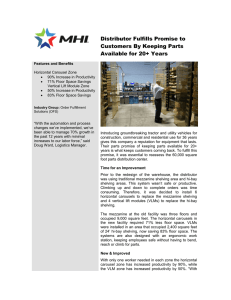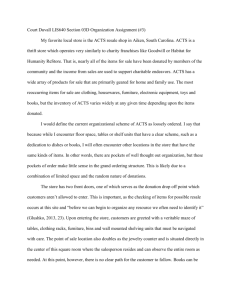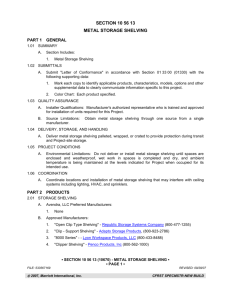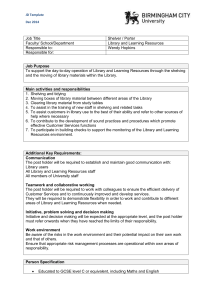SHELVING & STORAGE General requirements for shelving include
advertisement
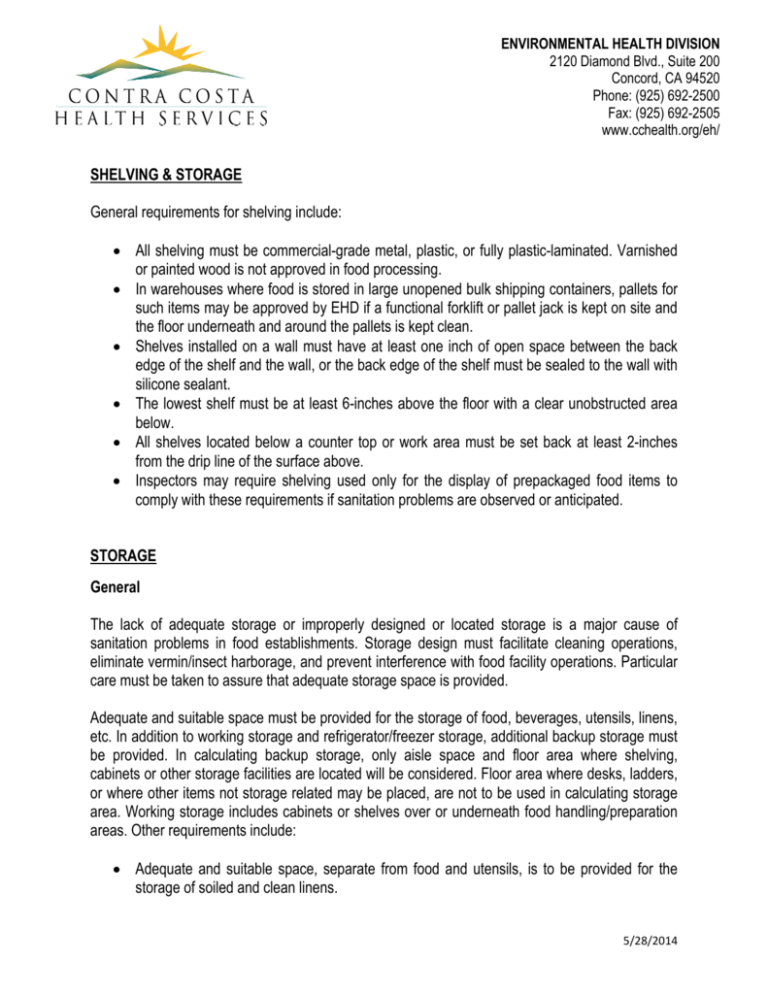
ENVIRONMENTAL HEALTH DIVISION 2120 Diamond Blvd., Suite 200 Concord, CA 94520 Phone: (925) 692-2500 Fax: (925) 692-2505 www.cchealth.org/eh/ SHELVING & STORAGE General requirements for shelving include: All shelving must be commercial-grade metal, plastic, or fully plastic-laminated. Varnished or painted wood is not approved in food processing. In warehouses where food is stored in large unopened bulk shipping containers, pallets for such items may be approved by EHD if a functional forklift or pallet jack is kept on site and the floor underneath and around the pallets is kept clean. Shelves installed on a wall must have at least one inch of open space between the back edge of the shelf and the wall, or the back edge of the shelf must be sealed to the wall with silicone sealant. The lowest shelf must be at least 6-inches above the floor with a clear unobstructed area below. All shelves located below a counter top or work area must be set back at least 2-inches from the drip line of the surface above. Inspectors may require shelving used only for the display of prepackaged food items to comply with these requirements if sanitation problems are observed or anticipated. STORAGE General The lack of adequate storage or improperly designed or located storage is a major cause of sanitation problems in food establishments. Storage design must facilitate cleaning operations, eliminate vermin/insect harborage, and prevent interference with food facility operations. Particular care must be taken to assure that adequate storage space is provided. Adequate and suitable space must be provided for the storage of food, beverages, utensils, linens, etc. In addition to working storage and refrigerator/freezer storage, additional backup storage must be provided. In calculating backup storage, only aisle space and floor area where shelving, cabinets or other storage facilities are located will be considered. Floor area where desks, ladders, or where other items not storage related may be placed, are not to be used in calculating storage area. Working storage includes cabinets or shelves over or underneath food handling/preparation areas. Other requirements include: Adequate and suitable space, separate from food and utensils, is to be provided for the storage of soiled and clean linens. 5/28/2014 A room, area, shelving, or cabinet separated from food preparation, food storage, utensil washing and utensil storage areas is to be provided for storing all cleaning equipment, cleaning supplies, and poisonous substances. Typically, the janitorial sink area is a good location to store these items. If located in a food preparation area, poisonous substances are to be stored in a separate approved enclosure (e.g., cabinet). All food, except those stored in the original large unopened bulk containers are to be stored at least 6-inches above the floor. Large containers of bulk foods in original unopened containers may be stored on dollies or pallets less that 6-inches high if these are easily cleanable and readily movable—and a functional forklift or pallet jack is kept on site. Storage areas or rooms must open up into the establishment. “Remote” food or utensil storage outside of the establishment is not allowed. Calculating Storage Space Needs In addition to working storage and refrigerator/freezer storage, backup storage must be provided. General guidelines for calculating the minimum required storage: Provide backup storage shelving equivalent to 25% of all kitchen space or one square foot of shelving per customer seat, whichever is greater (minimum 144 square foot of approved shelving). Provide sufficient approved shelving dispersed throughout the kitchen or other storage area(s). Bars or bar areas must have at least 72 square feet of backup storage shelving. Establishments selling only prepackaged products must have an area or room at least 30 square feet in size, with at least 72 square feet of approved shelving. Each separate department in a supermarket or other large food establishment must have its own backup storage meeting these requirements. These formulas are most applicable to smaller establishments. Larger facilities will require significantly more storage space. 5/28/2014
